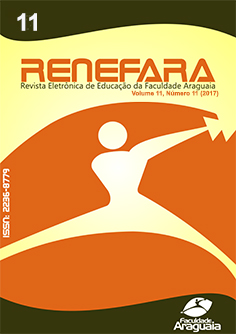BULLYING IN PHYSICAL EDUCATION CLASSES
Keywords:
Bullying, Physical Education, School Violence.Abstract
This research intends to analyze how Physical Education classes can help in avoiding the practice of bullying. This study provides reflections and discussions, aiming to improve the participation and the intervention of educational institutions. The objective of this research is to understand how Physical Education classes can contribute in the prevention and reduction of bullying in school environment, once it is important to be aware of the consequences that such phenomenon can bring to society. This quali-quantitative research obtained its data through an interview with a private institution teaching in the city of Goiânia and by analysis of secondary information in governmental data banks, such as PenSE 2016 (Pesquisa Nacional de Saúde na Escola). Bullying among students is a complex problem, there are no simple solutions for their reduction, and their acts are present in all schools. The most recent Brazilian survey are presented in the PenSE (2016) and show the most present bullying in relationships between boys (7.6%) and in relationships among girls (7.2%). From this study it is considered that there is a substantive influence of the sport in the school scope. And sometimes physical education professionals work focusing only on physical abilities, and thus, make physical education generate the segregation and exclusion of those considered "unfit" to certain sports modalities, thus promoting bullying in classes . It is fundamental more effective training and interventionist processes to deal with violence in the school context, especially to bullying.
Downloads
Published
Issue
Section
License
The copyright of the published articles will be transferred to the Uniaaraguaia Magazine, allowing its subsequent reproduction as transcription and with due citation of source. In the event of acceptance and before the publication of the article, the plaintiff (s) shall write a statement formally transferring copyright to the magazine.
The author may also print and distribute copies of his article, provided that he mentions that the rights belong to the Uniaaraguaia Magazine.
Author rights include the right to reproduce in full or partly by any means, distribute this article, including figures and photographs.
By submitting originals to the Uniaaraguaia magazine, the author or authors express agreement with the following terms:
a) Authors maintain copyright and grant Uniaraguaia magazine the right of first publication, with the work simultaneously licensed under the Creative Commons Attribution license that allows the sharing of work with recognition of the authorship and initial publication in this magazine.
b) Authors are authorized to assume additional contracts separately, for non-expiration distribution of the work version published in this magazine (eg publish in institutional repository or as book chapter), with recognition of authorship and initial publication in this journal.
c) Authors are allowed and are encouraged to publish and distribute their work online (eg in institutional repositories or on their personal page) to any point before or during the editorial process, as this can generate productive changes as well as increase the impact and citation of published work.

